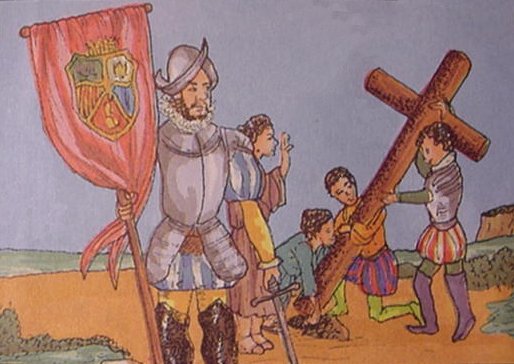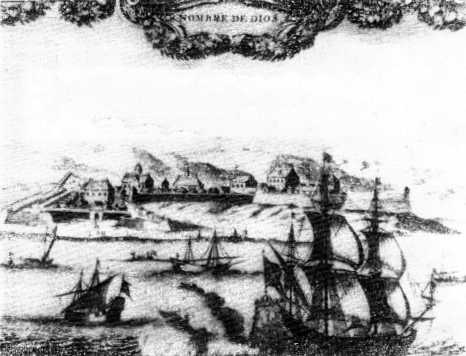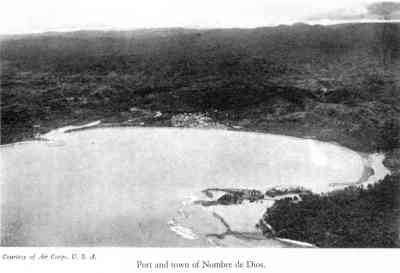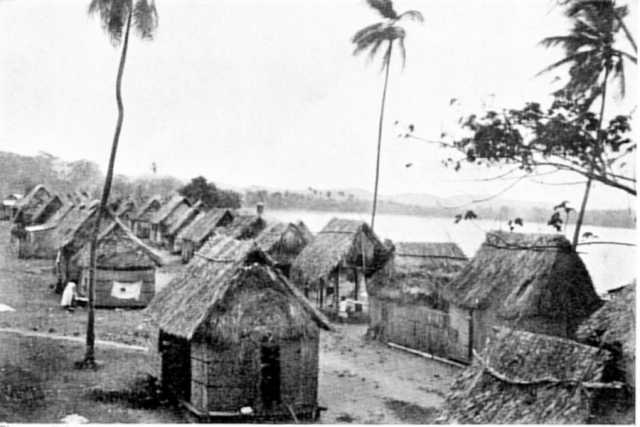
|
||
|
1750 Map of Panama Showing San Lorenzo, Nombre de Diós & Porto Bello |
||
|
Rodrigo de Bastidas, was a leader of an expedition of exploration, that set sail from Spain in October, 1500, in two ships. Vasco Nuñez de Balboa and Juan de la Cosa, were members of the expedition. They reached what is now know has Venezuela, and continued sailing west along it coast. They sailed past el Cabo de Vela, and reaching el Golfo de Darien, explored it, and the Atrato River. They continued north, along the coast as far as El Retrete, possibly as far as the site were Nombre de Diós, would be founded years later, and even as far as the future site of Porto Bello. Bastidas did not name these two, sites, and it would be up to others, to name them. Because of this, Bastidas has been given the credit for the discovery of Panamá. Christopher Columbus sailed on his fourth and last voyage of exploration, from Cadiz on May 11, 1502. With him on this voyage was Bartolomé Columbus, his brother, and his second son, Fernando. Stopping off in Española, he had the opportunity to confer with Bastidas, and examine his charts. He sailed west, past Cuba, and landed on the northern coast of Honduras, east of the Yucatan. Skirting the coast of Tierra Firme, he sailed east over the Honduras hump and then south east. He continued skirting the coast of Central America, past Honduras, Nicaragua and Costa Rica. On October 6, 1502, they entered Almirante Bay, in what is now known as Panamá. Columbus continued along the coast, eastward, past Chiriqui and Veraguas, past the Chagres River, and the Bay of Limon, until he reached a beautiful bay, that he named Puerto Bello on November 2nd, 1502. They were forced to stay there 7 days, due to inclement weather. By November 24, he had reached the most eastward he would travel on the coast of Panama, at a harbor, that he named El Retrete. The next person to enter the bay of Nombre de Diós, was Diego de Nicuesa, the appointed governor of Castilla del Oro. He had the benefits of both Bastides and Columbus' charts, and was headed to Veraguas, where Columbus had discovered much gold. He had sailed west to the Almirante Bay, and then turned east, in search of Veraguas, and his new lands. They entered the harbor of Puerto Bello, and some of his men were killed by the natives. Nicuesa was given the distinction by the Spanish as the discoverer of "Puerto Bello", what he officially named it, since he actually entered the harbor and explored the area in 1509. Others attribute the discovery and naming to Christopher Columbus. Fearful of the belligerent natives in the area, he continued east, searching for a friendly place to settle, and establish his capital. He eventually arrived in a harbor, where the land appeared fertile, and the coast was suitable for building a fort, and Nicuesa ordered, "Paremos aquí, en el nombre de Diós". Here they founded the town of Nombre de Diós, the first permanent Spanish settlement in Tierra Firme in early1510. A little later that year Martín Fernández de Enciso and Vasco Nuñez de Balboa established the community of Nuestra Señora de la Antigua del Darien in his territory. The residents of Antigua voted to remove Enciso as their leader since they did not like his autocratic rule and Balboa reminded him that they were in the territory of Nicuesa. When the residents at Antigua, realized that Nicuesa was in a settlement west of them, the invited him to come and be their leader. Nicuesa left the town of Nombre de Diós, where they were starving and in very bad shape, to the striving town of Antigua, to oust Balboa, but was ousted himself, and on March 1, 1511, he was set adrift in a leaky boat, and was never heard from again. At this point, all of the settlers at Nombre de Diós, accepted Balboa's offer, to relocate to Antigua, and the settlement of Nombre de Diós, was abandoned. Diego de Albites, a captain who had accompanied Pedrarias from Spain to Tierra Firme, helped establish Panamá in 1517. With permission from Pedrarias, to colonize Veraguas, he sailed form Antigua in 1518. He never reached Veraguas, but he attempted to establish a settlement at Puerto Bello in 1518. In 1519 moved and reestablished the settlement that Nicuesa abandoned, Nombre de Diós. This settlement remained as the northern terminus of the trans-isthmian trade. Panama and Nombre de Diós are opposite each other, and gradually, a paved road (El Camino Real) was built connecting both settlement. When the gold from Peru, was shipped to Spain, it was shipped to Panama, on the Pacific, and crossed the isthmus on El Camino Real, to Nombre de Diós, and then shipped to Spain yearly on the Treasure Fleet. The history of Tierra Firme, was controlled by these two settlements for the next 60 years.
|
||
|
||
|
Nombre de Diós was located 18 leagues from the city of Panamá. It never really prospered as a permanent community. The
weather was very wet and humid, the heat was excessive, as were all towns on the northern coast of Panama,
and very unhealthy. Many Spaniards, that came to Nombre de Diós,
with the Fleet, died there hence, the name of "The Grave-Yard of
the Spaniards". There were about 200 home in town, but must of
them were empty most of the year. The population of the settlement was
about 50 permanent residents. When ever the Treasure Fleet would
arrive from Spain with trade
goods for Tierra Firme and South America and to pick up the treasures from America,
the population of the town would increase to over 5,000.
When the fleet arrived in Cartagena, a messenger was sent to Panamá, informing the governor that it had arrived. He would make the arrangements to transport all of the wealth that had accumulated there from Peru and South America. As soon as the Plate Fleet arrived from Peru, the governor would send word to the admiral of the fleet as to what day the cargo would arrive in Nombre de Diós (and later, Porto Bello). Large mule trains were used to transport all of the gold and silver ingots across the Isthmus, over the Camino Real to Nombre de Diós. These mule trains were called recuas, and consisted of 100 mules with their muleteers and soldiers, that served as guards. The heavy and bulky articles were sent by way of the Cruces Trail, overland to the village of Cruces on the banks of the Chagres River, and then down river in boats. From the mouth of the Chagres River, the merchandize was transported to Nombre de Diós, by coastal ships. Once the fleet arrived in Nombre de Diós, the governor of Panamá would meet with representatives of the merchants bringing supplies, and those buying, to determine what was going to be the price of the articles, during the 60 days of the fair. In the plaza, next to the Custom House, the sailors from the ships would erect large tents, from the sails of the ships, where all of the merchandise from the ships was unloaded. During the 3 months of the Fair, space was at a premium. Houses that were empty most of the year, would rent for 5,000 to 6,000 pesos while a small room would go for 1,000 pesos. Merchants from all over the new world would arrive, and the population would increase by over 2,000. The town would fill with Negro and Indian slaves, soldiers sent there for protection of the treasures, servants for the masters of the fine homes that had been empty during most of the year. And the merchants that brought their goods to be sold, and those who came to buy. The bay offered poor protection from storms in the North Sea (Caribbean) and may ships were lost during storms in the harbor. In 1565, an entire Spanish fleet, under the command of Aguayo, was lost there during a storm. In December 23, 1533, the governor, Capitan Barrionuevo, wrote that the camino between Panama and Nombre de Diós, was in terrible state of disrepair, and in of extensive repair, which would be expensive. In February 22, 1535, the bishop of Panamá, to pick up the treasures from America and the King of Spain, in which he complained of the terrible road and the lack of beast of burden and of subsistence, and how unhealthy it was. He called Nombre de Diós as a den of thieves and graveyard of travelers. Nombre de Diós, was so unhealthy, that the Spaniards said that Indian women living here became barren, and even the native fruits refused to grow. Strong men did not live out the usual span of their life, and all Spanish children died in infancy. Spanish mother would have to go to Cruces when ready to give birth, and the children had to stay in Cruces, until they were five or six years old, if they were to reach maturity. By the middle of the 16th century, there were hundreds of runaway Negro slave who had intermarried with the Indians of the area, and had established many settlements in the area. They were a thorn in the side of the Spaniards, since they were always attacking the Treasure Trains, that were on the Camino Real, and at times, even attacking Nombre de Diós. In 1554, the new viceroy Mendoza, on his way to Peru, stopped in Nombre de Diós and ordered Pedro de Ursua to capture and subjugate these outlaws. The Cimarron's were under the command of one of them, by the name of Bayano, and they referred to him as their King. After two years of warfare, Bayano was captured and sent to prison in Spain. A treaty was drawn up, granting the runaway slaves their freedom, with the agreement that they would not take up arms against the Spaniards. This truce did not last long, and the Cimarron's became friendly with the English, French and Dutch buccaneers that were frequent visitors to the Isthmus. |
||
|
On July 29, 1572, Francis Drake, captured the town of Nombre de Diós. He attacked the town, with a force of 73 men, in three pinnaces and a shallop. After a bloody battle, he was able to defeat the defenders. Shortly there after, reinforcements arrived from Panamá, Drake was wounded, and they had to retreat, without much loot. The left behind silver bars, valued at a million pounds sterling, and other treasures. In their fighting, they reached the doors of the Kings Treasure House, but were not able to enter it, before the Spaniards counter attacked. On April 1, 1573, Drake attacked Nombre de Diós again, this time capturing a mule train, loaded with treasure, outside of Nombre de Diós. This time, they took every thing they could carry. In August, 1595, with a fleet of 26 ships, Drake set out to Panama again, hoping to take Nombre de Diós and the city of Panama. Crossing the isthmus on the Camino Real, his forces were stopped, by well prepared Spaniards. When they got back to Nombre de Diós, they proceeded to burn the city, and then sailed to Puerto Bello. Drake got sick on the way, and died. On January 29, 1596, he was buried at sea in the harbor.
|
||
|
|
||
|
In 1586, the Italian engineer, Juan Bautista Antonelli, was sent by the King of Spain, to examine the different ports in the Caribbean, and make suggestions on how to improve them. Antonelli already had the distinction of having designed several of the major fortresses in the Spanish Indies. At the time, Nombre de Diós was the site where all ships were loaded with treasures for the return to Spain, and Puerto Bello was a small town of only 10 houses. After noting the excellent port facilities and defensible terrain, he wrote to King Felipe of his findings. "If it might please your Majesty, it would be a good idea that the city of Nombre de Diós be brought and built in this harbor". The king ordered the move, and San Felipe de Puertovelo was founded on March 20, 1597 by Don Francisco de Valverde y Mercado. He was a factor of New Spain (Mexico) and a comisario. The residents of Nombre de Diós were moved to the new town site (a distance of about 5 leagues). Puertovelo was granted the title of city by orders of Valladolid granted to Nombre de Diós November 23, of 1537. The coat of arms granted to Nombre de Diós on December 7, 1537, was also transferred to Puertovelo. The coat-of-arms was a castle and ship, bordered with the inscription "Tierra Firme, Breñas de oro"
|
||
|
Alcedo said "It is of bad temperature, moist and rainy; for which reasons, and also because the port of Portobello was preferable. The city was removed to this last mentioned place by order of Philip II and in 1585, by Don Iñigo de la Mota, when the former city became reduced to a miserable village. Its port was being frequented by foreign vessels, which carried on a contraband trade. The English pirate Francis Drake sacked the city in 1598. The chief of squadron Don Francisco Cornejo had off the coast a combat with two Dutch frigates in 1734. That the Count de Clavijo, who was commander of the Guarda Costas, (Coast Guard) also had two other engagements in the following years of 1725 and 1726. The English Admiral Hosier blockaded in this port, for a whole year, some galleons under the command of Lieutenant General Don Blas de Lego, in 1538.
|
||
|
||
|
||
| Panama History | Home |




